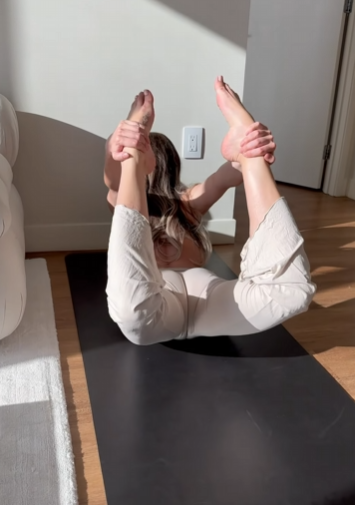
When it comes to unlocking mobility and releasing tension in the lower body, few movements rival the simplicity and effectiveness of deep hip circles. Often overlooked in everyday exercise routines, hip circles provide a dynamic way to engage, stretch, and strengthen the muscles surrounding the hips, pelvis, and lower back. When done mindfully and with full awareness of the body, this movement can alleviate tightness, enhance flexibility, and promote overall balance in both athletic performance and daily life.
The hips are the body’s central powerhouse. They transfer energy between the upper and lower body, stabilize movements, and allow for fluid motion in walking, running, bending, and twisting. Over time, sedentary lifestyles, prolonged sitting, and repetitive physical activities can lead to stiffness in this crucial region. Hip circles, particularly when performed deeply and slowly, address these issues by mobilizing the hip joint in all directions and gently massaging the surrounding muscles.
To begin a deep hip circle, it is important first to establish proper posture. Standing upright with feet slightly wider than shoulder-width apart, the spine should be tall, shoulders relaxed, and core gently engaged. Some people prefer to place their hands on their hips to better feel the movement of the pelvis. From this starting position, the hips are moved in circular patterns, tracing a smooth, continuous path. These circles can be performed clockwise and counterclockwise, forward and backward, depending on the specific goal—whether it’s warming up the joints, increasing flexibility, or releasing tension.

One of the key benefits of deep hip circles is the activation and elongation of the hip flexors. These muscles, located at the front of the hip, are often shortened due to prolonged sitting. Tight hip flexors can cause a domino effect, affecting the lower back, knees, and even posture. By incorporating deep, deliberate circles, these muscles are lengthened and strengthened simultaneously, which can improve both mobility and stability. Over time, individuals may notice improved range of motion in movements such as lunges, squats, or even simple daily activities like climbing stairs.
Another muscle group that benefits from deep hip circles is the gluteal complex. The gluteus maximus, medius, and minimus are not only responsible for hip extension but also for lateral stability and rotation. When performing hip circles, these muscles engage as the pelvis moves in multiple planes, promoting coordination and balance. Athletes, dancers, and yoga practitioners often incorporate hip circles into their warm-up routines because of the way they enhance dynamic control of the hips. Even for non-athletes, these movements are a gentle yet powerful way to strengthen muscles that often remain underutilized.
The deep hip circle also stimulates the sacroiliac joint and surrounding fascia. The sacroiliac joint, which connects the sacrum to the pelvis, plays a critical role in load transfer and movement efficiency. Many people experience discomfort or stiffness in this area due to inactivity or biomechanical imbalances. Deep, mindful circles encourage fluid motion through this joint, increasing lubrication, reducing tension, and improving functional alignment. This not only helps prevent lower back pain but also supports better posture throughout the day.

Breath plays an essential role in maximizing the benefits of deep hip circles. Coordinating the breath with the movement enhances relaxation and helps the body move more fluidly. For instance, inhaling deeply while lifting and opening the hips, and exhaling as the hips trace the downward or inward portion of the circle, encourages both muscular engagement and mental focus. This combination of breath and movement can make hip circles meditative, reducing stress and promoting a sense of groundedness. Over time, this mindful approach fosters body awareness, teaching practitioners to notice areas of tightness or restriction that might otherwise go unnoticed.
One of the most versatile aspects of deep hip circles is their adaptability. They can be performed in various positions depending on one’s needs or physical limitations. While standing circles are excellent for engaging the entire body and improving balance, seated circles offer a gentler option for those with limited mobility or joint sensitivity. On the floor, lying circles allow for even greater range of motion and can be used as part of a rehabilitation program or yoga flow. Props such as a stability ball or resistance band can also be incorporated to add support, challenge, or intensity.
In addition to the physical benefits, deep hip circles cultivate mental focus and presence. Unlike repetitive linear movements, circular motions require coordination and attention, making them an effective mindfulness exercise. Practicing these movements daily can train the nervous system to move more efficiently and reduce tension stored in the body. Many practitioners report that integrating hip circles into their morning routine helps them feel more energized and centered, while incorporating them into a cooldown sequence promotes relaxation and recovery after strenuous activity.

For those seeking a deeper connection with their body, combining deep hip circles with complementary practices can yield remarkable results. Yoga poses such as pigeon, lizard, or butterfly stretches can further open the hips and enhance flexibility. Strength exercises like squats, lunges, or bridges can be paired with circles to create a balanced routine of mobility and stability. Even simple daily activities, such as mindful walking or seated rotations, can reinforce the benefits of this movement.
It is worth noting that, as with any exercise, proper technique and gradual progression are key. Performing hip circles too quickly, with poor alignment, or without awareness can reduce their effectiveness and increase the risk of strain. Beginners are encouraged to start with smaller circles, focusing on smooth and controlled motion. Gradually, as the hips open and muscles strengthen, the range and depth of the circles can be increased. Listening to the body, avoiding pain, and maintaining a relaxed yet engaged posture ensures both safety and optimal results.
In conclusion, deep hip circles are a deceptively simple yet profoundly effective movement that targets one of the most important areas of the body. By increasing mobility, strengthening key muscles, improving joint health, and promoting mindfulness, this practice offers both physical and mental benefits. Whether incorporated as part of a warm-up, a daily mobility routine, or a restorative sequence, deep hip circles remind us that movement does not need to be complicated to be powerful. Through consistency, awareness, and intention, the hips can become more open, flexible, and resilient, supporting overall well-being and a greater ease of movement in life’s many activities.
Deep hip circles with focus, control, and mindful breathing are more than just an exercise—they are a practice of connection with one’s body, a celebration of mobility, and an invitation to move with freedom and joy.



